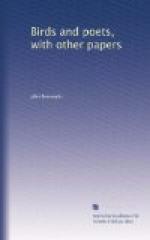I have noticed that the bobolink does not sing the same in different localities. In New Jersey it has one song; on the Hudson, a slight variation of the same; and on the high grass-lands of the interior of the State, quite a different strain,—clearer, more distinctly articulated, and running off with more sparkle and liltingness. It reminds one of the clearer mountain air and the translucent spring-water of those localities. I never could make out what the bobolink says in New Jersey, but in certain districts in this State his enunciation is quite distinct. Sometimes he begins with the word gegue, gegue. Then again, more fully, be true to me, Clarsy, be true to me, Clarsy, Clarsy, thence full tilt into his inimitable song, interspersed in which the words kick your slipper, kick your slipper, and temperance, temperance (the last with a peculiar nasal resonance), are plainly heard. At its best, it is a remarkable performance, a unique performance, as it contains not the slightest hint or suggestion, either in tone or manner or effect, of any other bird-song to be heard. The bobolink has no mate or parallel in any part of the world. He stands alone. There is no closely allied species. He is not a lark, nor a finch, nor a warbler, nor a thrush, nor a starling (though classed with the starlings by late naturalists). He is an exception to many well-known rules. He is the only ground-bird known to me of marked and conspicuous plumage. He is the only black and white field-bird we have east of the Mississippi, and, what is still more odd, he is black beneath and white above,—the reverse of the fact in all other cases. Preeminently a bird of the meadow during the breeding season, and associated with clover and daisies and buttercups as no other bird is, he yet has the look of an interloper or a newcomer, and not of one to the manner born.
The bobolink has an unusually full throat, which may help account for his great power of song. No bird has yet been found that could imitate him, or even repeat or suggest a single note, as if his song were the product of a new set of organs. There is a vibration about it, and a rapid running over the keys, that is the despair of other songsters. It is said that the mockingbird is dumb in the presence of the bobolink. My neighbor has an English skylark that was hatched and reared in captivity. The bird is a most persistent and vociferous songster, and fully as successful a mimic as the mockingbird. It pours out a strain that is a regular mosaic of nearly all the bird-notes to be heard, its own proper lark song forming a kind of bordering for the whole. The notes of the phoebe-bird, the purple finch, the swallow, the yellowbird, the kingbird, the robin, and others, are rendered with perfect distinctness and accuracy, but not a word of the bobolink’s, though the lark must have heard its song every day for four successive summers. It was the one conspicuous note in the fields around that the lark made no attempt to plagiarize. He could not steal the bobolink’s thunder.




